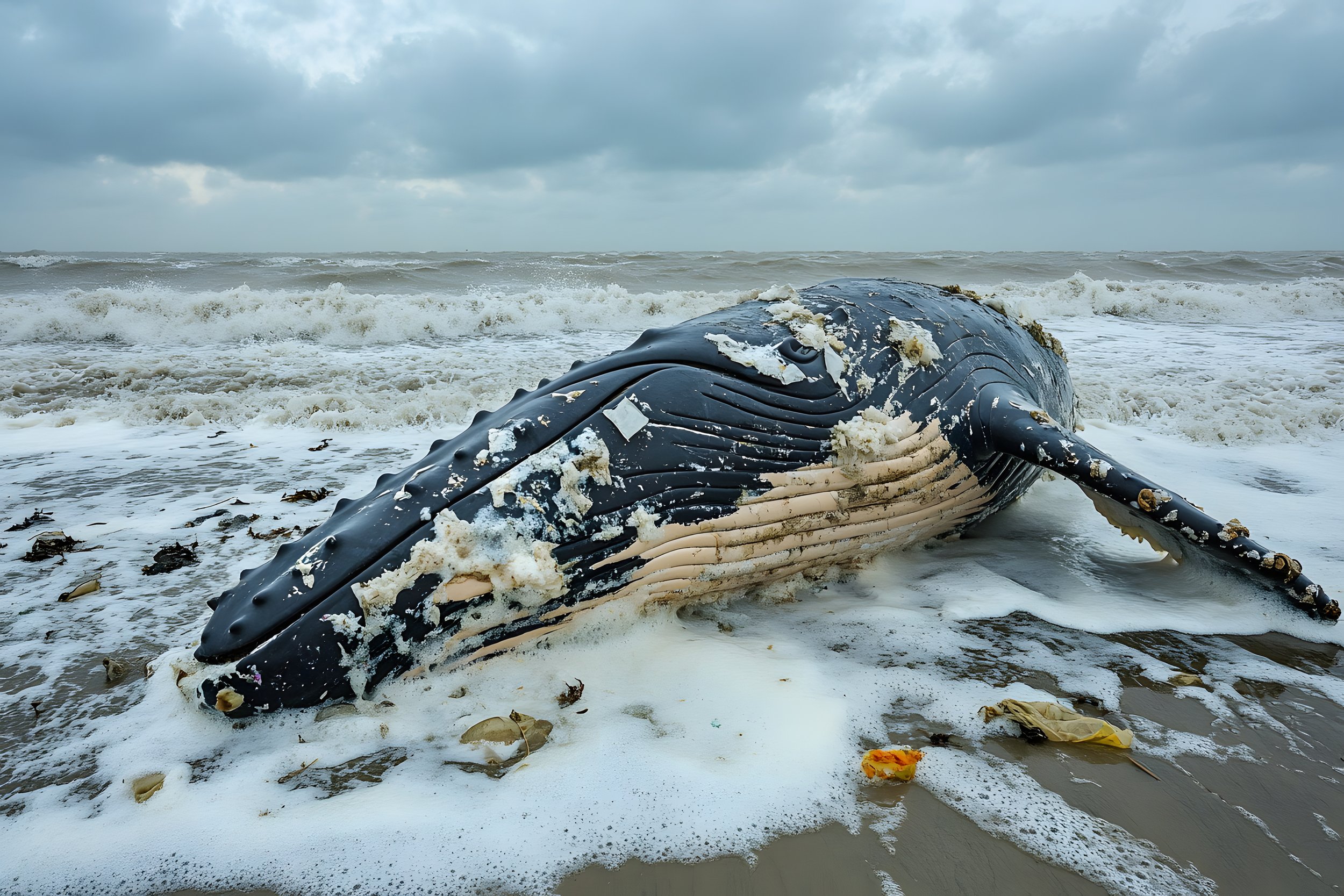
Balloons Kill Wildlife!
Stop Releasing Balloons Outside!
Together let’s Ban the Release of Balloons in New Jersey!
Released Balloons result in the injury or death of many wild animals, especially coastal wildlife.
Let’s face it, to the average person, balloons seem harmless; and appear cute, colorful, and charming. They are low cost and come in all kinds of sizes, colors and patterns. Why would anyone want to ban the release of balloons?
A wayward balloon found on a beach in Port Monmouth, NJ in 2019.
BECAUSE releasing balloons in the sky can often result in the injury or death of many wild animals, especially to coastal wildlife since about 71 percent of Planet Earth is made up of water.
Helium-filled balloons and their fragments are making their way to the coast — and hurting or killing coastal animals in the process.
A 2015 academic paper presents good evidence that balloons are among the most dangerous types of pollution for coastal wildlife, along with fishing gear and plastic bags. A 2017 report from Ocean Conservancy has ranked balloons as a top deadly form of litter, behind discarded fishing nets and plastic bags. Releasing balloons is just another way of littering, since all balloons will return to the ground or water to pollute, including those falsely marketed as “biodegradable.”
Newly released balloons found on the beach near Raritan Bay in the Borough of Union Beach, NJ, spring 2021.

Save Coastal Wildlife has identified three (3) main problems with balloons getting released in the outdoor environment.
1) Balloons kill wildlife!
Balloons will eventually land, most of the time in or near the water, and when they do, balloons do not discriminate among living things. Balloons released into the environment, especially in coastal areas, pose a significant threat to wildlife, as they can be ingested, causing blockages, or animals can become entangled in strings, leading to injury or death.
Marine animals, like sea turtles and seabirds, often mistake balloons for food, such as jellyfish or squid, and can ingest them, leading to blockages in their digestive systems and starvation.
Balloons and their strings can entangle wildlife, causing injuries, restricting movement, and even leading to drowning or suffocation.
Balloons are non-biodegradable and can persist in the environment for years, continuing to pose a threat to wildlife.
Scientists have found balloons and balloon fragments in the stomachs of stranded whales, dolphins, seals, and sea turtles. For example, in 1985 a 15-foot-long juvenile sperm whale washed up on a New Jersey beach with a balloon in its stomach. Two years later in September 1987 a leatherback sea turtle washed up dead in New Jersey with a balloon in its digestive tract contributing to its death.
2. Many Wild Animals Become Entangled in Balloon String
While it's impossible to pinpoint an exact number, countless animals, including seabirds, sea turtles, whales, and dolphins, get entangled in balloon strings or ingest balloons, leading to injury, illness, or death. Balloons and their strings pose significant threats to wildlife, both on land and in the ocean. Animals can become entangled in strings, which can strangle them or restrict their movement.
Examples of Harm:
Seabirds: Can become entangled in balloon ribbons or strings, which can wrap around their necks, beaks, or legs, causing injury or death.
Sea Turtles: May mistake deflated balloons for jellyfish, a natural food source, and ingest them, leading to digestive problems or death.
Marine Mammals: Dolphins and whales can become entangled in balloon strings or ingest balloons, causing injury or death.
Bird Carcass entangled by balloon string. Credit: Virginia Stranding Response Program
Balloon string wrapped around a stick. Found at Long Branch, NJ. Summer 2021
A Pair of Balloons found on the ocean beach in Sandy Hook Gateway National Recreation Area, NJ. Spring 2021
3. Balloons are Trash!
Balloons also negatively impact the physical environment by littering our beaches, parks, preserves, public lands and waterways. For example, sometime around 2014, more than a hundred balloons were collected at Edwin B. Forsythe National Wildlife Refuge in New Jersey during a public cleanup, and that’s just the number that made it to this one particular beach.
Even balloons marketed as biodegradable or “eco-friendly” because they are plant based can still take years to disintegrate, meaning they’re not any better for the environment than standard balloons. According to Debra Duncan from the Environmental Nature Center in Newport Beach, CA, “there are two types of balloons in general use – latex and mylar. Although latex balloons are considered bio-degradable, this will take anywhere from 6 months to 4 years to decompose and they can wreak a lot of havoc before they do.” She goes on to write that, “in one experiment researchers observed that balloons floating in seawater deteriorated much slower, and even after 12 months, still retained their elasticity.”
The Florida based Balloons Blow organization also shows on their website that releasing “biodegradable” latex balloons can take four years or more to fully breakdown. Starting in 2011, they followed the life of a balloon exposed to intense Florida sun, wind, water and torrential rains; and siting in the soil. Over five years, fragments of the latex balloon were still intact.
A loose balloon found during a beach cleanup in winter 2020 in the Borough of Union Beach, NJ.
Balloons released by people into the sky during a celebration return to the land and sea (this is called gravity) where they can be mistaken for food and eaten by animals including sea turtles, dolphins, whales, fish and birds. Quite a few dead animals found in the water or on a beach have been reported with balloons in their stomachs, or balloon ribbon and string caused their death by entanglement.
BALLOONS RELEASED DURING A HUSKER GAME. The Nebraska Cornhuskers (often abbreviated to Huskers), play their home games at Memorial Stadium, located on the campus of the University of Nebraska–Lincoln in Lincoln, Nebraska. Balloons can travel far, sometimes a balloon from a Husker game can be found along the East Coast of the United States.
Balloons Can Travel Far Away From Where They Were Released.
Even if balloons are released far away from the coast, they often still end up along the coast or in the ocean, because Planet Earth is mostly a blue planet with over 70 percent water.
Balloons have been found to travel hundreds, even thousands of miles to the coast. “For example, a balloon released during the opening ceremony of the Olympic Games in Nagano, Japan on February 7, 1998 was found a mere 49 hours later in Los Angeles, California. It was calculated that this balloon traveled 5,300 miles at an average of more than 100 miles per hour.”
Another example of how far balloons can travel is exemplified in New York State, on the southern shore of Long Island near the hamlet of Amagansett, not far from Montauk. In November 2018, a person found an intact Husker balloon that travelled 1,400 miles away from a Nebraska football game. University of Nebraska football fans have a long-held tradition of releasing thousands of balloons upon the Huskers’ first touchdown in Memorial Stadium. While local environmentalists and some students have expressed concerns about the balloons' environmental impact, including littering and potential harm to wildlife, the tradition continues with some people estimating that around 13,350 balloons are released per game based on a photo of two sections of the stadium, extrapolating to 45 sections. With approximately seven homes games per football season, that’s over 90,000 red balloons released into the environment every year!

SOLUTIONS!
The solution is simple – don’t release balloons outdoors!
Unfortunately, the temptation is always there for some uninformed person or group to release balloons into the sky for a celebration. For example, in 2017 several people released 100 helium-filled balloons in Hardyston Township, NJ for a special event.
Save Coastal Wildlife is seeking a total ban of releasing balloons outdoors in New Jersey.
Not just along the coast, but a ban throughout the State of New Jersey.
Some municipalities and organizations are taking steps to discourage or prohibit the release of balloons due to the environmental and wildlife risks, including the U.S. Fish and Wildlife Service, which asks that Americans cease the release of balloons.
BUT WE NEED TO DO MORE!
It Will Not Be Easy Creating A State-Wide Ban On Releasing Balloons in New Jersey!
While several states already have legislation regulating the release of balloons, including Connecticut, California, Virginia, and Florida, it will not be easy to do the same in New Jersey.
Why?
The Balloon Council, a lobbying organization of retailers, distributors and manufacturers formed in 1990 to inform people and politicians about how great balloons are, is located in Trenton, NJ.
Writer Michael Waters in an April 26, 2018 article in the Outline tells us that in 2017, the Balloon Council “funneled $344,099 into state lobbying efforts.” The article goes on to state that their primary target in all that spending is to fight anti-balloon environmental laws in New Jersey that the council worries will create a negative narrative about balloons and cripple the industry. The Balloon Council has also spent hundreds of thousands of dollars in the past few years defeating proposed bans across the nation.
Just look what happened in California in 2008. Waters writes in his article that “when California was considering an outright ban on the sale of foil balloons, the Council sprung into action….They bankrolled a movement called Save Our Balloons. The website featured a photo of a crying baby girl beside the ominous text: “It’s true. California politicians want to pop her balloon.” Although sponsors of the California bill pointed to a 2007 study showing that balloons get stuck in power lines and cause up to $120 million in damages annually, the Balloon Council’s warnings prevailed. In September 2008, then-Governor Arnold Schwarzenegger vetoed the bill.”
This is why in New Jersey, environmental organizations often go town to town in an effort to ban the release of balloons. The effort is slow and tedious, but is taking hold. There are around 14 New Jersey towns with balloon releasing bans, including Atlantic City, Atlantic Highlands, Bradley Beach, Long Beach Township, and Tinton Falls.
How can you help?
Please email, tweet, post a message on Facebook or send a letter to your New Jersey State senator and two assembly people and the New Jersey Governor. Please tell them and everyone that all released balloons, including those falsely marketed as “biodegradable latex,” return to the ground and water as ugly litter.
Instead of using balloons - use a bubble machine to release many many many harmless bubbles into the sky. Bubbles are fun and can create stunning photographs. Watching thousands of bubbles float up into the sky can be an amazing sight and just as symbolic as seeing several balloons float away, but without damage to the environment.
One Green Planet suggests planting native trees and wildflowers is a beautiful way to create a memory that lasts for years to come – and give a little something back to nature. Another fun idea is to have people release milkweed seeds, which helps populations of monarch butterflies thrive by replenishing depleted supplies of the milkweed plant that is essential to their survival.
Please visit the Balloons Blow website for more information, more ways to help, and alternatives to releasing balloons into the sky.
Pieces of a balloon and string found at Monmouth Beach, NJ 2019.
Sources:
(1) Balloon Litter on Virginia’s Remote Beaches:Results of Monitoring from 2013 through 2017
A report from Clean Virginia Waterways of Longwood University to the Virginia Coastal Zone Management Program for the FY16 Task 94.03 Grant
August 2018
Submitted by:
Christina Trapani, Christina Trapani Consulting
Kathryn O’Hara, Marine Scientist, Independent Contractor
Katie Register, Clean Virginia Waterways of Longwood University










